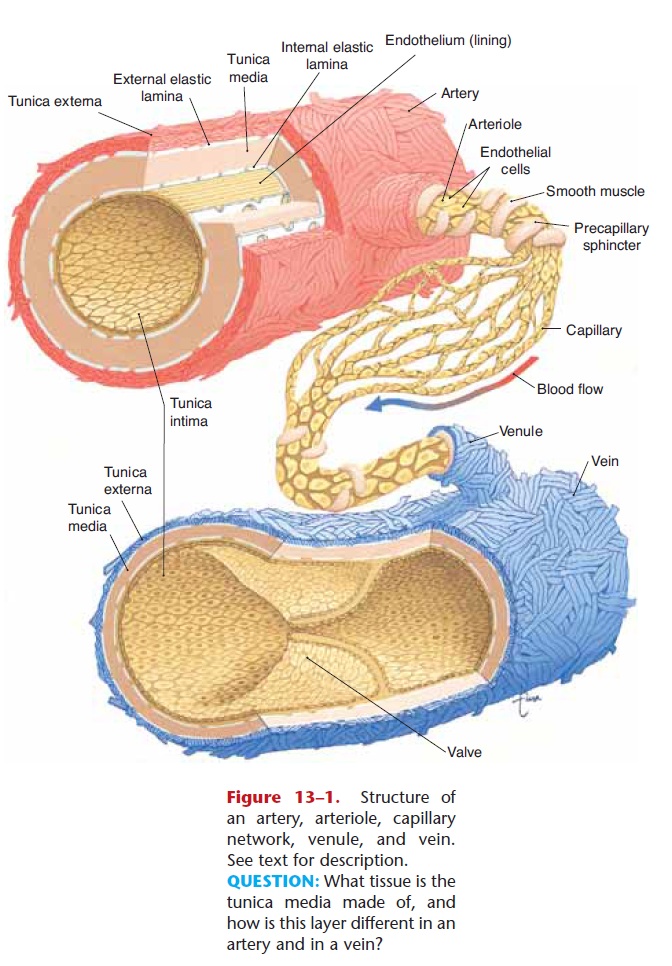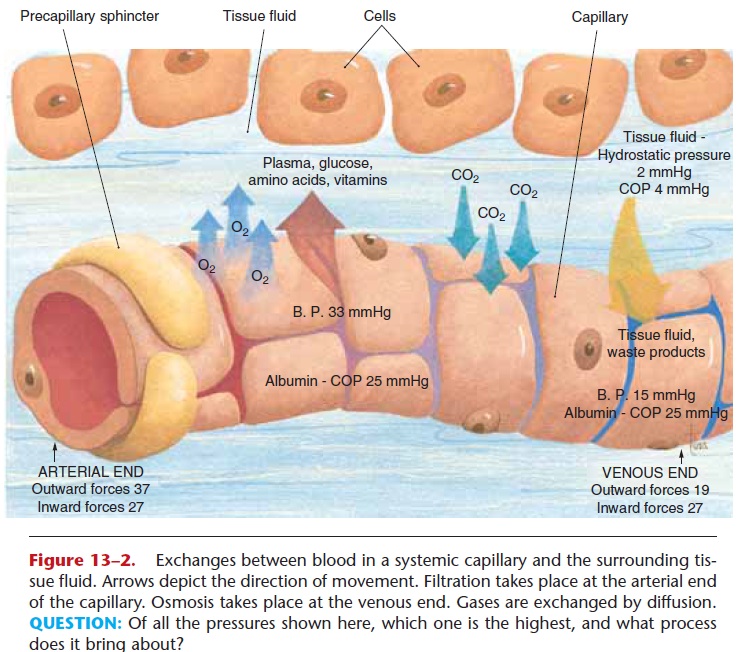Chapter: Essentials of Anatomy and Physiology: The Vascular System
Capillaries - Anatomy and Physiology
CAPILLARIES
Capillaries carry blood from arterioles to venules. Their walls are only one cell in thickness; capillaries are actually the extension of the endothelium, the simple squamous lining, of arteries and veins (see Fig. 13–1). Some tissues do not have capillaries; these are the epidermis, cartilage, and the lens and cornea of the eye.
Most tissues, however, have extensive capillary networks. The quantity or volume of capillary networks in an organ reflects the metabolic activity of the organ. The functioning of the kidneys, for example, depends upon a good blood supply. Fig. 18–2 shows a vascular cast of a kidney; you can see how dense the vessels are, most of which are capillaries. In contrast, a tendon such as the Achilles tendon at the heel or the patellar tendon at the knee would have far fewer vessels, because fibrous connective tissue is far less metabolically active.

Blood flow into capillary networks is regulated by smooth muscle cells called precapillary sphincters, found at the beginning of each network (see Fig. 13–1). Precapillary sphincters are not regulated by the nerv-ous system but rather constrict or dilate depending on the needs of the tissues. Because there is not enough blood in the body to fill all of the capillaries at once, precapillary sphincters are usually slightly constricted. In an active tissue that requires more oxygen, such as exercising muscle, the precapillary sphincters dilate to increase blood flow. These automatic responses ensure that blood, the volume of which is constant, will circu-late where it is needed most.
Some organs have another type of capillary called sinusoids, which are larger and more permeable than are other capillaries. The permeability of sinusoids permits large substances such as proteins and blood cells to enter or leave the blood. Sinusoids are found in the red bone marrow and spleen, where blood cells enter or leave the blood, and in organs such as the liver and pituitary gland, which produce and secrete proteins into the blood.
EXCHANGES IN CAPILLARIES
Capillaries are the sites of exchanges of materials between the blood and the tissue fluid surrounding cells. Some of these substances move from the blood to tissue fluid, and others move from tissue fluid to the blood. The processes by which these substances are exchanged are illustrated in Fig. 13–2.
Gases move by diffusion, that is, from their area of greater concentration to their area of lesser concen-tration. Oxygen, therefore, diffuses from the blood in systemic capillaries to the tissue fluid, and carbon dioxide diffuses from tissue fluid to the blood to be brought to the lungs and exhaled.

Let us now look at the blood pressure as blood enters capillaries from the arterioles. Blood pressure here is about 30 to 35 mmHg, and the pressure of the surrounding tissue fluid is much lower, about 2 mmHg. Because the capillary blood pressure is higher, the process of filtration occurs, which forces plasma and dissolved nutrients out of the capillaries and into tissue fluid. This is how nutrients such as glucose, amino acids, and vitamins are brought to cells.
Blood pressure decreases as blood reaches the venous end of capillaries, but notice that proteins such as albumin have remained in the blood. Albumin contributes to the colloid osmotic pressure (COP) of blood; this is an “attracting” pressure, a “pulling” rather than a “pushing” pressure. At the venous end of capillaries, the presence of albumin in the blood pulls tissue fluid into the capillaries, which also brings into the blood the waste products produced by cells. The tissue fluid that returns to the blood also helps maintain normal blood volume and blood pressure.
The amount of tissue fluid formed is slightly greater than the amount returned to the capillaries. If this were to continue, blood volume would be gradu-ally depleted. The excess tissue fluid, however, enters lymph capillaries. Now called lymph, it will be returned to the blood to be recycled again as plasma, thus maintaining blood volume.
Related Topics